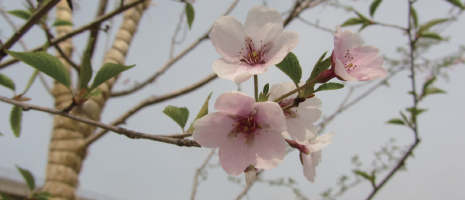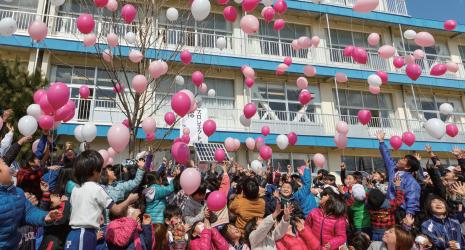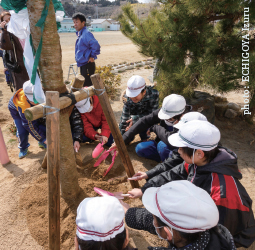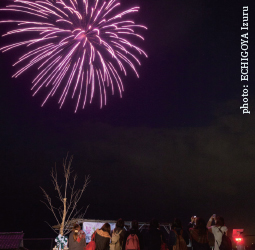Home > Highlighting JAPAN >Highlighting Japan March 2016>Five Years Down the Road to Reconstruction
Highlighting JAPAN


Hope Blossoms
Symbols have a powerful effect on the human spirit, and the living symbol of a cherry tree that survived the tsunami after the Great East Japan Earthquake inspired one man to plant others to hearten communities shattered by the disaster.
Takashi Murakami, the director of local art organization MMIX Lab, was living in Miyagi Prefecture’s Sendai City when the Great East Japan Earthquake struck in March 2011, bringing with it a devastating tsunami. Observing an area the wave had devastated, Murakami says he was surprised to see a lone sakura (cherry tree) flowering. “I was struck by the thought that cherry blossoms are still blooming even amid this terrible destruction,” he says.
“Cherry trees are special to the Japanese,” Murakami adds, explaining how the delicate pink flowers that begin to appear around mid-March are quickly swept away by early April, coinciding with the changing of the school year. As in many countries around the world, students in Japan enjoy their school lives up until they enter the workforce, and spring is a season that marks a turning point in the course of their development: this is the season young people change their way of life, part ways with school friends or meet new ones, and begin their adult lives in a new environment.
Such change is not limited just to students; since the fiscal years of most Japanese companies follow the same cycle, sakura signify a beginning perhaps even more powerfully than New Year’s. Given that this coincides with the disaster’s timing, Murakami found sakura especially fitting as a symbol of recovery and renewal for the Tohoku region.
In March 2012, Murakami launched the Sakura 3.11 School Project to plant sakura in Tohoku. Disasters of the magnitude of the Great East Japan Earthquake, known as the 3.11 event, are said to occur only once in a thousand years. Murakami therefore selected the Edo-Higan-Sakura variety, which if conditions are right can live nearly a thousand years. As the ten-year-old trees were over seven meters tall when planted, they bloom the following year, serving as both memorials and markers to future generations of the zone of safety where the tsunami had not reached.
Murakami decided to plant the hardy cherry trees at various kindergartens, primary schools and junior high schools in the four prefectures the tsunami ravaged—Aomori, Iwate, Miyagi and Fukushima. In the aftermath of 3.11, homeless survivors had congregated at local schools. Where others saw only despair, Murakami says, “I saw in these places the birth of a new community.” His goal for the project is to have schools become the center of community reconstruction and allow children to share their memories with the generations that follow.
Drawing on his organization’s experience, Murakami and the staff organize various activities to engage students and the community through art at the planting ceremonies. They put on art workshops for the schoolchildren, and students take part in the preparation and actual tree planting. Representatives from the previous recipient school pass on a cherry blossom baton, send balloons with handwritten messages on them soaring into the sky, and record video messages to be shown to students at the next school. In the finale, sakura-colored fireworks light up the night.
During the balloon message ceremony, schoolchildren write their hopes and dreams on pink balloons and then release them into the air en masse, which resembles cherry blossom petals swept up by the wind. Murakami recalls that at the first ceremonies in 2012, children wrote statements such as “I want to return home,” or “I want to spend more time with my family.” As a new generation of children passes through the school, however, he reports that the messages now express wishes for things to come many years in the future, detailing what they want to be when they grow up, for example.
The tsunami affected nearly two hundred schools in the four prefectures. With trees already planted at twelve schools, Murakami’s goal is to plant many Edo-Higan-Sakura trees over the next decade. Despite the painful memories, these cherry trees are sure to stand as a testament to hope and the power of community for many generations to come.
© 2009 Cabinet Office, Government of Japan








